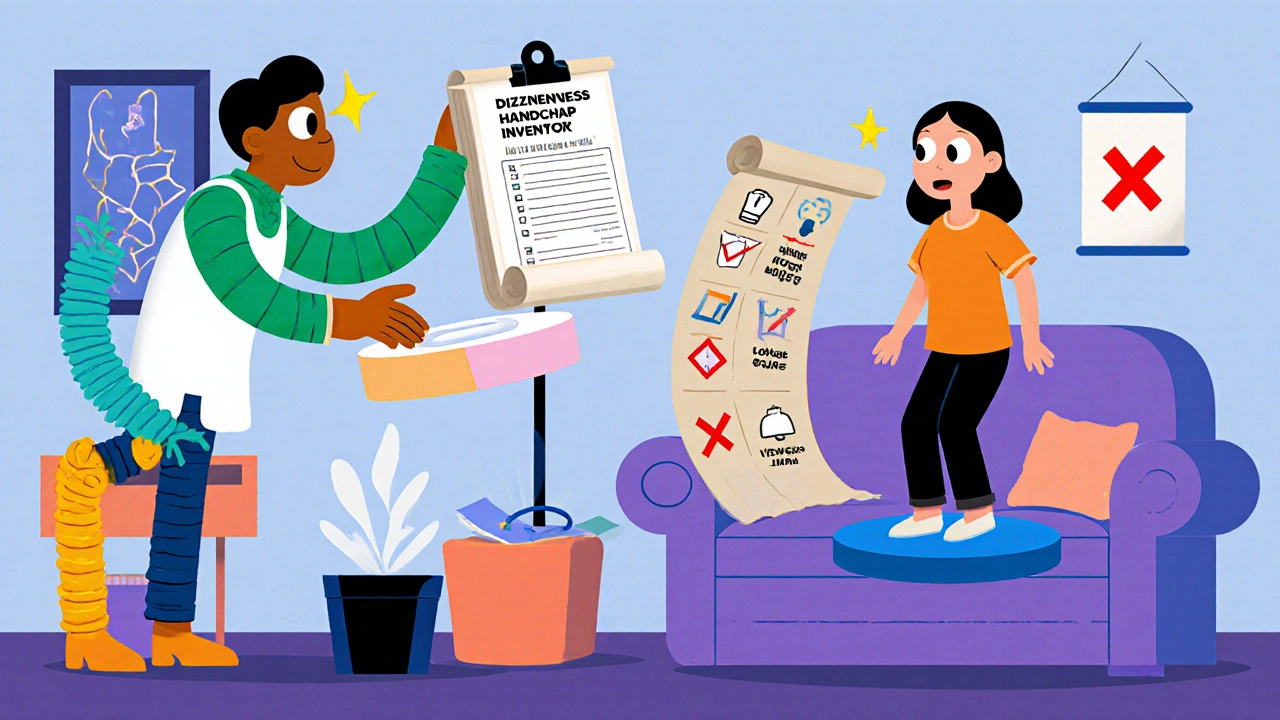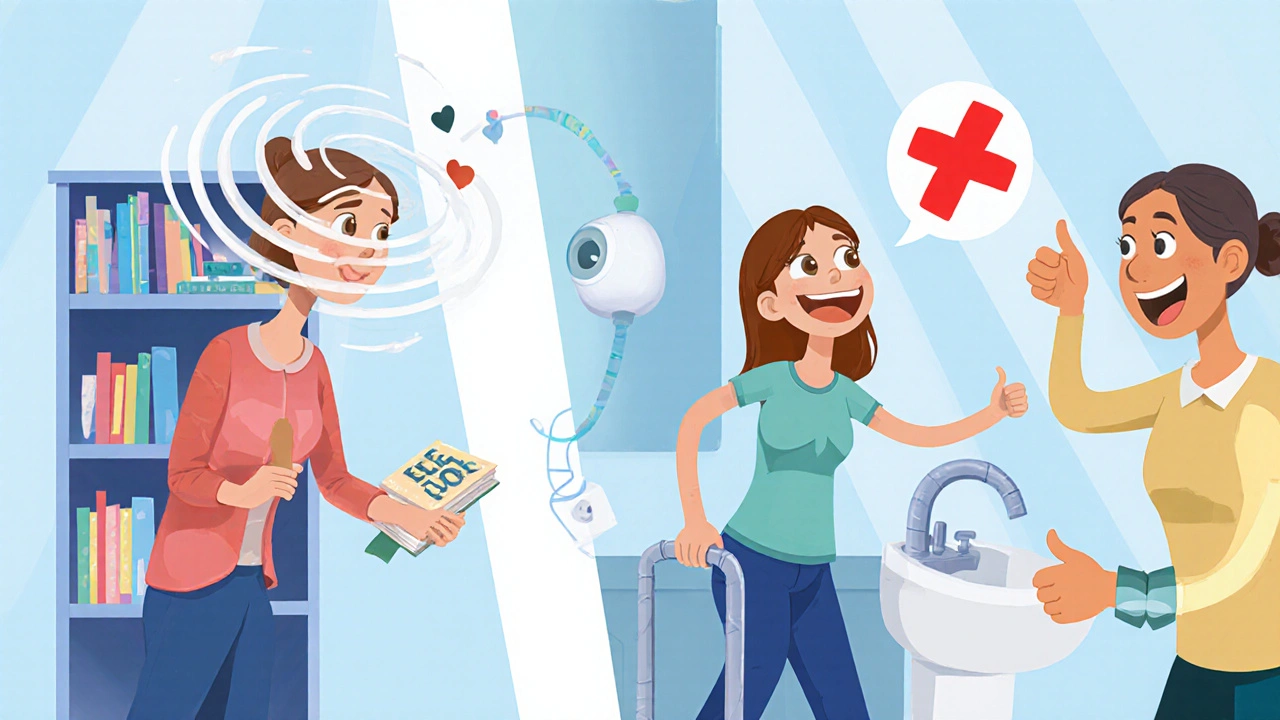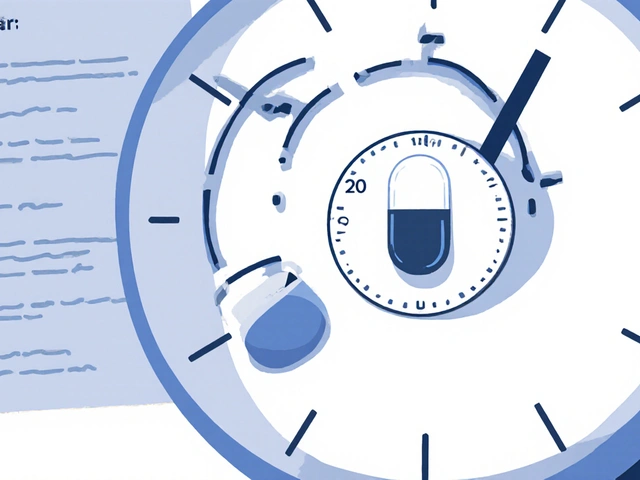Key Takeaways
- Occupational therapy (OT) targets the everyday activities that trigger or worsen dizziness.
- OT assesses balance, visual‑vestibular integration, and the safety of home environments.
- Tailored interventions include vestibular rehabilitation exercises, activity pacing, and adaptive equipment.
- Combining OT with patient education cuts fall risk by up to 40% in chronic dizziness cases.
- Regular re‑evaluation ensures the plan evolves with the client’s progress.
Ever felt the world spin when you stand up to get a glass of water? That unsettling sensation-dizziness-doesn’t just happen in a clinic; it invades kitchens, offices, and even bedtime routines. While doctors often prescribe medication or refer you to a physiotherapist, many don’t realize that occupational therapy can be the missing link that turns the dizzy spell into a manageable part of life.
Below we’ll walk through what occupational therapists do, why their focus on daily activities matters, and how you can use their tools to stay steady, confident, and independent.
What Is Occupational Therapy and How Does It Relate to Dizziness?
Occupational therapy is a client‑centered health profession that helps people perform everyday activities-called activities of daily living (ADLs)-despite physical, cognitive, or sensory challenges. When dizziness interferes with cooking, dressing, or even sitting at a desk, OT steps in to evaluate the root causes and redesign the tasks so they become safer and easier.
Understanding Dizziness: Types and Triggers
Dizziness is an umbrella term that includes vertigo, presyncope, disequilibrium, and light‑headedness. The most common culprits are:
- Benign paroxysmal positional vertigo (BPPV) - brief bursts when you tilt your head.
- Vestibular hypofunction after an infection or injury.
- Medication side‑effects, especially antihypertensives.
- Deconditioning and poor balance control.
Each type may require a slightly different therapeutic approach, but all share a common goal: restore confidence in moving through the world.
Core OT Assessment Tools for Dizziness
Before prescribing exercises, an OT conducts a thorough assessment. Key tools include:
- Clinical Test of Sensory Interaction and Balance (CTSIB) - evaluates how vision, somatosensory input, and vestibular function contribute to stability.
- Dizziness Handicap Inventory (DHI) - a questionnaire that quantifies how dizziness affects daily life.
- Home‑environment safety check - looks for loose rugs, poor lighting, and clutter that increase fall risk.
These assessments generate a personalized profile that guides the therapy plan.

Intervention Strategies: From Vestibular Rehab to Activity Modification
Occupational therapists blend several evidence‑based techniques:
- Vestibular rehabilitation exercises - eye‑head coordination drills, gaze stabilization, and habituation movements designed to recalibrate the inner‑ear balance system.
- Task‑specific training - practicing real‑world actions (e.g., reaching for a cup) while maintaining a stable posture.
- Activity pacing - breaking chores into smaller steps to avoid sudden postural changes that trigger dizziness.
- Adaptive equipment - using weighted utensils, grab bars, or built‑in seat cushions to enhance stability.
- Patient education - teaching strategies such as slow head movements, proper hydration, and medication timing.
Because OT focuses on the context of each activity, the interventions feel relevant and instantly applicable.
Comparing OT and PT Approaches to Dizziness
| Aspect | Occupational Therapy (OT) | Physical Therapy (PT) |
|---|---|---|
| Primary Goal | Enable safe participation in daily activities | Improve overall balance and gait mechanics |
| Typical Exercises | Gaze‑stabilization, functional reach, ADL rehearsal | Strengthening, treadmill gait training, dynamic balance drills |
| Environment Focus | Home and work settings; task analysis | Clinic or gym; movement patterns |
| Equipment Used | Adaptive kitchen tools, low‑tech balance aids | Balance boards, resistance bands, parallel bars |
| Outcome Measures | DHI, ADL performance scores | Timed Up‑and‑Go, Berg Balance Scale |
Both disciplines often collaborate, but OT’s unique angle is its emphasis on the “how” of everyday tasks, ensuring that improvements translate to real life.
Case Example: Sarah’s Journey from Vertigo to Confidence
Sarah, a 68‑year‑old retired teacher in Bristol, began experiencing BPPV after a mild head injury. Medications helped a bit, but she still felt unsteady when reaching for books on high shelves. Her OT performed a CTSIB, identified a visual‑vestibular mismatch, and created a program that included:
- Daily gaze‑stabilization drills for 5minutes.
- Rearranging kitchen cabinets to a reachable height.
- Installing grab bars in the bathroom.
- Teaching her to pause and perform a slow head turn before leaning.
After eight weeks, Sarah’s DHI score dropped from 58 (severe) to 12 (mild), and she reported no falls. Her story illustrates how OT bridges the gap between clinical improvement and daily safety.

Tips for Getting the Most Out of OT for Dizziness
- Be honest about symptom triggers. The more detail you give, the better the therapist can tailor exercises.
- Keep a dizziness diary - note time of day, activity, and medication.
- Practice prescribed exercises daily, even if they feel easy.
- Ask for a home‑modification checklist; small changes often make big differences.
- Schedule regular follow‑ups to adjust the plan as you improve.
When to Seek Occupational Therapy
If you notice any of the following, an OT evaluation is worth considering:
- Frequent light‑headedness when bending or standing.
- Difficulty performing familiar tasks like cooking or buttoning shirts.
- Recent falls or near‑falls linked to a sense of spinning.
- Medication changes that coincide with new balance problems.
- Desire to return to work or hobbies despite lingering dizziness.
Most NHS trusts and private clinics in the UK provide OT services either via referral from a GP or through a direct request for vestibular rehabilitation.
Frequently Asked Questions
Can occupational therapy cure dizziness?
OT doesn’t “cure” the underlying medical condition in every case, but it can dramatically reduce the impact of dizziness on daily life by improving balance, teaching coping strategies, and modifying the environment.
How long does a typical OT program for dizziness last?
Programs usually run 6-12 weeks with 1-2 sessions per week, plus daily home exercises. Progress is reassessed every 2-3 weeks to keep the plan on track.
Is OT covered by the NHS for dizziness?
Yes, if your GP or specialist refers you for vestibular rehabilitation. Private insurance often covers it as well, but check your plan details.
Do I need special equipment for OT exercises?
Most exercises use simple tools like a chair, a yoga mat, or a small weight. Therapists may recommend inexpensive items such as a balance pad or a reacher tool.
Can OT be combined with medication or other therapies?
Absolutely. OT works best alongside medication, physiotherapy, and lifestyle adjustments, creating a comprehensive plan that tackles dizziness from multiple angles.






11 Comments
It is absolutely scandalous how often the simple truth is ignored: dizziness isn’t just a fleeting inconvenience, it is a profound assault on one’s autonomy. Occupational therapy offers a principled, evidence‑based avenue to reclaim daily function, yet many clinicians dismiss it with barely a nod. By targeting the very activities that provoke vertigo, OT transforms the home from a minefield into a sanctuary. The moral imperative is clear – we must champion these interventions before another fall shatters a life. Ignorance is no longer an excuse.
Wow, what a fantastic reminder of why OT matters!!! 🙌 It’s so encouraging to see how these therapists turn everyday struggles into victories. Keep spreading the word – every share could save someone from a nasty tumble!!!
Occupational therapists bring a uniquely client‑centered perspective to dizziness management that complements the more traditional physiotherapy approaches. First, they conduct comprehensive assessments such as the Clinical Test of Sensory Interaction and Balance, which parse out how vision, somatosensory input, and vestibular function each contribute to stability. The Dizziness Handicap Inventory then quantifies the subjective impact on daily living, providing a solid baseline for tracking progress. After gathering this data, therapists design individualized programs that embed vestibular rehab exercises directly into functional tasks, like reaching for a mug while maintaining head alignment. This task‑specific training not only improves physiological adaptation but also builds confidence in real‑world contexts. Additionally, OTs perform home‑environment safety audits, identifying hazards such as loose rugs or poor lighting that exacerbate fall risk. Simple modifications-installing grab bars, rearranging kitchen cabinets, or using weighted utensils-can dramatically reduce episodes of disequilibrium. Education is another cornerstone; patients learn to hydrate appropriately, time medication intake, and execute slow head movements before transitional postures. The interdisciplinary nature of OT means they often collaborate with physicians and physiotherapists to ensure a cohesive care plan. Evidence shows that combining OT with patient education can cut fall risk by up to forty percent in chronic dizziness populations. Regular re‑evaluation every two to three weeks allows the therapist to adjust exercise intensity, monitor symptom trends, and reinforce adherence. Moreover, the emphasis on activity pacing prevents over‑exertion, which is a common trigger for vertigo flare‑ups. For individuals with BPPV, specific habituation maneuvers are taught and practiced until the positional triggers subside. In cases of vestibular hypofunction, gaze‑stabilization drills are progressed progressively to restore vestibulo‑ocular reflex function. Finally, the therapist documents outcomes using both objective measures, like the Berg Balance Scale, and patient‑reported outcomes, ensuring a comprehensive picture of recovery. All of these components together illustrate why occupational therapy is not merely an adjunct but a central pillar in effective dizziness management.
Thnks for the detailed breakdown. I guess the only thing I’d add is that some ptients might find the ovals of the assessments a bit intimidating.
I completely understand the concern about intimidation – the key is to introduce each test slowly and reassure the individual that discomfort is temporary. In practice, therapists often demonstrate the CTSIB movements first, allowing the client to observe before attempting themselves. This gentle pacing aligns perfectly with the OT philosophy of client‑centred care and can significantly ease anxiety. Moreover, providing a clear written summary of what to expect helps demystify the process and builds trust.
OT is a game‑changer for dizziness.
Frankly, it’s absurd that anyone would rely on foreign‑born therapists when we have home‑grown solutions that cut costs and keep our veterans safe. The market is saturated with imported programs that don’t respect our unique demographics – we need a home‑grown OT curriculum now.
Thank you for sharing this comprehensive overview 😊. It’s helpful to see how each component fits together, and I’ll definitely consider asking my GP about a referral.
Awesome! Let’s get those grab bars up and start those eye‑head drills today – you’ve got this! 🚀
Sounds like another pharma push to keep us dependent.
I hear your frustration, and it’s true that profit motives can muddy the waters 😠. Still, many people genuinely benefit from OT, so it’s worth looking into reputable providers.